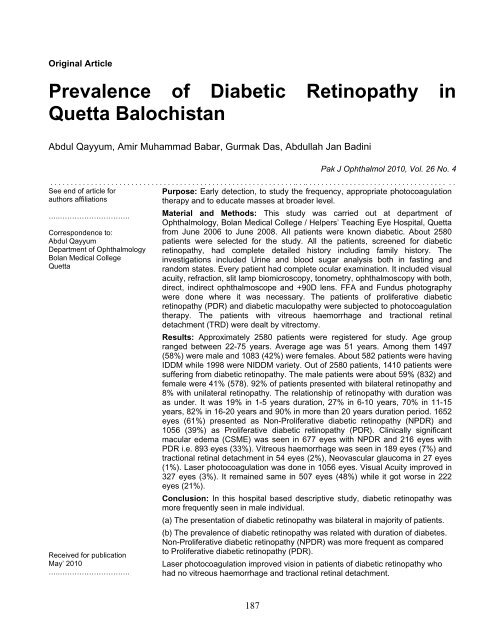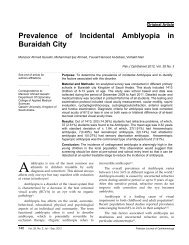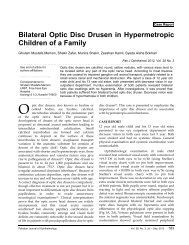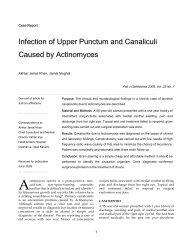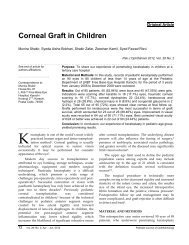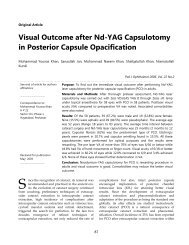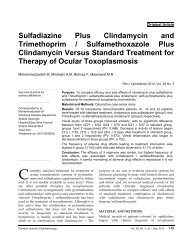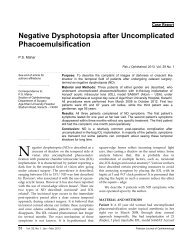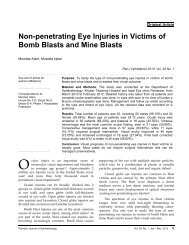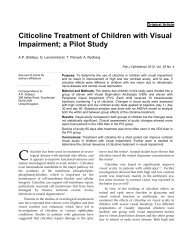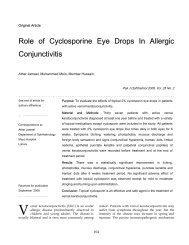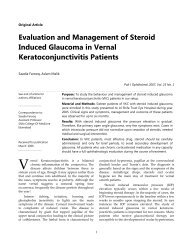Prevalence of Diabetic Retinopathy in Quetta Balochistan - Pakistan ...
Prevalence of Diabetic Retinopathy in Quetta Balochistan - Pakistan ...
Prevalence of Diabetic Retinopathy in Quetta Balochistan - Pakistan ...
Create successful ePaper yourself
Turn your PDF publications into a flip-book with our unique Google optimized e-Paper software.
Orig<strong>in</strong>al Article<br />
<strong>Prevalence</strong> <strong>of</strong> <strong>Diabetic</strong> <strong>Ret<strong>in</strong>opathy</strong> <strong>in</strong><br />
<strong>Quetta</strong> <strong>Balochistan</strong><br />
Abdul Qayyum, Amir Muhammad Babar, Gurmak Das, Abdullah Jan Bad<strong>in</strong>i<br />
Pak J Ophthalmol 2010, Vol. 26 No. 4<br />
. . . . . . . . . . . . . . . . . . . . . . . . . . . . . . . . . . . . . . . . . . . . . . . . . . . . . . . . . . . . .. . .. . . . . . . . . . . . . . . . . . . . . . . . . . . . . . . . . . . . .<br />
See end <strong>of</strong> article for<br />
Purpose: Early detection, to study the frequency, appropriate photocoagulation<br />
authors affiliations<br />
therapy and to educate masses at broader level.<br />
…..………………………..<br />
Correspondence to:<br />
Abdul Qayyum<br />
Department <strong>of</strong> Ophthalmology<br />
Bolan Medical College<br />
<strong>Quetta</strong><br />
Received for publication<br />
May’ 2010<br />
…..………………………..<br />
Material and Methods: This study was carried out at department <strong>of</strong><br />
Ophthalmology, Bolan Medical College / Helpers’ Teach<strong>in</strong>g Eye Hospital, <strong>Quetta</strong><br />
from June 2006 to June 2008. All patients were known diabetic. About 2580<br />
patients were selected for the study. All the patients, screened for diabetic<br />
ret<strong>in</strong>opathy, had complete detailed history <strong>in</strong>clud<strong>in</strong>g family history. The<br />
<strong>in</strong>vestigations <strong>in</strong>cluded Ur<strong>in</strong>e and blood sugar analysis both <strong>in</strong> fast<strong>in</strong>g and<br />
random states. Every patient had complete ocular exam<strong>in</strong>ation. It <strong>in</strong>cluded visual<br />
acuity, refraction, slit lamp biomicroscopy, tonometry, ophthalmoscopy with both,<br />
direct, <strong>in</strong>direct ophthalmoscope and +90D lens. FFA and Fundus photography<br />
were done where it was necessary. The patients <strong>of</strong> proliferative diabetic<br />
ret<strong>in</strong>opathy (PDR) and diabetic maculopathy were subjected to photocoagulation<br />
therapy. The patients with vitreous haemorrhage and tractional ret<strong>in</strong>al<br />
detachment (TRD) were dealt by vitrectomy.<br />
Results: Approximately 2580 patients were registered for study. Age group<br />
ranged between 22-75 years. Average age was 51 years. Among them 1497<br />
(58%) were male and 1083 (42%) were females. About 582 patients were hav<strong>in</strong>g<br />
IDDM while 1998 were NIDDM variety. Out <strong>of</strong> 2580 patients, 1410 patients were<br />
suffer<strong>in</strong>g from diabetic ret<strong>in</strong>opathy. The male patients were about 59% (832) and<br />
female were 41% (578). 92% <strong>of</strong> patients presented with bilateral ret<strong>in</strong>opathy and<br />
8% with unilateral ret<strong>in</strong>opathy. The relationship <strong>of</strong> ret<strong>in</strong>opathy with duration was<br />
as under. It was 19% <strong>in</strong> 1-5 years duration, 27% <strong>in</strong> 6-10 years, 70% <strong>in</strong> 11-15<br />
years, 82% <strong>in</strong> 16-20 years and 90% <strong>in</strong> more than 20 years duration period. 1652<br />
eyes (61%) presented as Non-Proliferative diabetic ret<strong>in</strong>opathy (NPDR) and<br />
1056 (39%) as Proliferative diabetic ret<strong>in</strong>opathy (PDR). Cl<strong>in</strong>ically significant<br />
macular edema (CSME) was seen <strong>in</strong> 677 eyes with NPDR and 216 eyes with<br />
PDR i.e. 893 eyes (33%). Vitreous haemorrhage was seen <strong>in</strong> 189 eyes (7%) and<br />
tractional ret<strong>in</strong>al detachment <strong>in</strong> 54 eyes (2%), Neovascular glaucoma <strong>in</strong> 27 eyes<br />
(1%). Laser photocoagulation was done <strong>in</strong> 1056 eyes. Visual Acuity improved <strong>in</strong><br />
327 eyes (3%). It rema<strong>in</strong>ed same <strong>in</strong> 507 eyes (48%) while it got worse <strong>in</strong> 222<br />
eyes (21%).<br />
Conclusion: In this hospital based descriptive study, diabetic ret<strong>in</strong>opathy was<br />
more frequently seen <strong>in</strong> male <strong>in</strong>dividual.<br />
(a) The presentation <strong>of</strong> diabetic ret<strong>in</strong>opathy was bilateral <strong>in</strong> majority <strong>of</strong> patients.<br />
(b) The prevalence <strong>of</strong> diabetic ret<strong>in</strong>opathy was related with duration <strong>of</strong> diabetes.<br />
Non-Proliferative diabetic ret<strong>in</strong>opathy (NPDR) was more frequent as compared<br />
to Proliferative diabetic ret<strong>in</strong>opathy (PDR).<br />
Laser photocoagulation improved vision <strong>in</strong> patients <strong>of</strong> diabetic ret<strong>in</strong>opathy who<br />
had no vitreous haemorrhage and tractional ret<strong>in</strong>al detachment.<br />
187
D<br />
iabetes mellitus is undoubtedly <strong>of</strong> an ancient<br />
orig<strong>in</strong> 1 . The history <strong>of</strong> diabetes mellitus is as<br />
old as medic<strong>in</strong>e itself. In the Pre-Christian<br />
ERA, “the honey ur<strong>in</strong>e” was described by Su’srute <strong>in</strong><br />
H<strong>in</strong>du medic<strong>in</strong>e and the flesh and the limbs to ur<strong>in</strong>e<br />
by Aretaeus <strong>of</strong> Cappadocia 2 . The diabetes mellitus is<br />
one <strong>of</strong> major cause <strong>of</strong> bl<strong>in</strong>dness <strong>in</strong> the World.<br />
In United States from 1980 through 1987, the<br />
annual prevalence <strong>of</strong> diabetes mellitus <strong>in</strong>creased 9%<br />
from 24.4 to 27.6 / 1000 United States residents 3 .<br />
Accord<strong>in</strong>g to WHO estimates <strong>in</strong> 1995, 4.3 million<br />
people <strong>in</strong> <strong>Pakistan</strong> had diabetes mellitus. It will swell<br />
up to 11.6 million by the year 2025 4 . Accord<strong>in</strong>g to<br />
<strong>Pakistan</strong> National Survey, overall prevalence <strong>of</strong><br />
diabetes mellitus is 11.47%. The advanced age,<br />
<strong>in</strong>heritance, excessive caloric <strong>in</strong>take, obesity, less<br />
physical activity and various forms <strong>of</strong> stress are<br />
associated risk factors 5 .<br />
Of all systemic diseases that affect eye, diabetes<br />
mellitus is the most common condition that leads to<br />
visual loss and bl<strong>in</strong>dness 6 . The diabetic ret<strong>in</strong>opathy<br />
now ranks with glaucoma and senile macular<br />
degeneration as the lead<strong>in</strong>g cause <strong>of</strong> bl<strong>in</strong>dness <strong>in</strong><br />
develop<strong>in</strong>g countries 7 . The prevalence <strong>of</strong> diabetic<br />
ret<strong>in</strong>opathy is related to the duration <strong>of</strong> diabetes<br />
mellitus. It occurs particularly <strong>in</strong> 5th to 7th decade <strong>of</strong><br />
life, 50% <strong>of</strong> cases appear between ages <strong>of</strong> 40 & 50<br />
years, only 51% (This percentage needs correction) <strong>in</strong><br />
first decade and 3% <strong>in</strong> eighth. The <strong>in</strong>cidence <strong>of</strong><br />
diabetic ret<strong>in</strong>opathy is <strong>in</strong>fluenced by several factors<br />
like, age <strong>of</strong> onset <strong>of</strong> diabetes, the length <strong>of</strong> its duration,<br />
the control <strong>of</strong> glycosuria, and above all, on the<br />
diligence <strong>of</strong> observer <strong>in</strong> search<strong>in</strong>g early lesion.<br />
Vageners et al po<strong>in</strong>ted out that prior to<br />
<strong>in</strong>troduction <strong>of</strong> <strong>in</strong>sul<strong>in</strong>; the <strong>in</strong>cidence <strong>of</strong> diabetic<br />
ret<strong>in</strong>opathy was 8.3%. Although after <strong>in</strong>troduction <strong>of</strong><br />
<strong>in</strong>sul<strong>in</strong>, the life span <strong>of</strong> diabetic becomes long, but<br />
unfortunately the <strong>in</strong>cidence <strong>of</strong> diabetic ret<strong>in</strong>opathy has<br />
<strong>in</strong>creased 8 . The <strong>in</strong>cidence is 27% dur<strong>in</strong>g first 5-10 years<br />
71% if the duration is more than 10 years and 90-95%<br />
after 30 years 9 .<br />
The diabetic ret<strong>in</strong>opathy is classified as Non-<br />
Proliferative diabetic ret<strong>in</strong>opathy (NPDR),<br />
Proliferative diabetic ret<strong>in</strong>opathy (PDR) and cl<strong>in</strong>ically<br />
significant macular edema (CSME). Non-Proliferative<br />
diabetic ret<strong>in</strong>opathy is described as mild moderate,<br />
severe and very severe. Proliferative diabetic<br />
ret<strong>in</strong>opathy (PDR) is described as early, high risk and<br />
advanced. Macular edema is more common cause <strong>of</strong><br />
visual bl<strong>in</strong>dness <strong>in</strong> diabetic patients 10 .<br />
MATERIAL AND METHODS<br />
This hospital based descriptive study was carried out<br />
at department <strong>of</strong> Ophthalmology, Bolan Medical<br />
College / Helpers Teach<strong>in</strong>g Eye Hospital, <strong>Quetta</strong> from<br />
June 2006 to June 2008.<br />
All the patients were selected from diabetic cl<strong>in</strong>ic<br />
which is held twice a week at department <strong>of</strong><br />
Ophthalmology Bolan Medical College <strong>Quetta</strong>.<br />
All the patients had detailed history and ocular<br />
exam<strong>in</strong>ation. The history <strong>in</strong>cludes chief compla<strong>in</strong>ts,<br />
both systemic and ocular, were registered. Type and<br />
duration <strong>of</strong> diabetes were thoroughly noted. The<br />
associated risk factors like hypertension, obesity,<br />
family history, social history <strong>in</strong>cludes smok<strong>in</strong>g and<br />
alcohol use were noted.<br />
The method and frequency <strong>of</strong> blood sugar<br />
monitor<strong>in</strong>g were assessed. Every patient had complete<br />
ocular exam<strong>in</strong>ation. It <strong>in</strong>cluded distance and near<br />
visual acuity assessment, refraction, slit lamp<br />
biomicroscopy, tonometry, fundoscopy – with direct<br />
and <strong>in</strong>direct ophthalmoscopy with 90D. Fundus<br />
Fluoresce<strong>in</strong> angiography and fundus photography<br />
was done where it was necessary. The treatment<br />
modalities comprised <strong>of</strong> conservative treatment <strong>in</strong><br />
non-proliferative diabetic ret<strong>in</strong>opathy.<br />
The laser photocoagulation was done <strong>in</strong> – Severe<br />
cases <strong>of</strong> PDR (PRP).<br />
Cl<strong>in</strong>ically significant Macular grid pattern edema<br />
(CSME).<br />
RESULTS<br />
The age group ranged from 21-72 years <strong>of</strong> age and the<br />
average age was 51 years (Table 1). Total 2850 diabetic<br />
patients were studied. All were known diabetics.<br />
Among them 1998 had NIDDM and 582 patients had<br />
IDDM variety (Table 2). The male patients were 58%<br />
(1497) while female patients were 42% (1083) (Table 3).<br />
The number <strong>of</strong> diabetic ret<strong>in</strong>opathy patients was 1410<br />
(Table 4). Among them 59% (832) were male and 41%<br />
(578) were females (Table 5). The presentation <strong>of</strong><br />
ret<strong>in</strong>opathy was bilateral <strong>in</strong> 1298 (92%) patients<br />
<strong>in</strong>clud<strong>in</strong>g 792 male (61%), 506 female (39%) and<br />
unilateral <strong>in</strong> 112 patients (8%), 75 male (58%), 47<br />
female (42%) (Table 6).<br />
The relationship <strong>of</strong> duration <strong>of</strong> diabetes with<br />
diabetic ret<strong>in</strong>opathy was as follows. It was 19% dur<strong>in</strong>g<br />
first 1-5 years, 27% <strong>in</strong> 6-10 years duration, 70% <strong>in</strong> 11-15<br />
years, 82% <strong>in</strong> 16-20 years while it was 90% <strong>in</strong> patients<br />
above 20 year <strong>of</strong> duration <strong>of</strong> diabetes. (Table 7).<br />
188
Table 1. Age distribution <strong>of</strong> patients studied (n = 2580)<br />
Age group<br />
Average age<br />
21-72 years<br />
51 years<br />
Table 2. Total number <strong>of</strong> patients studied with distribution<br />
<strong>of</strong> types <strong>of</strong> diabetes mellitus (n = 2580)<br />
Type <strong>of</strong> Diabetes No. <strong>of</strong> Patients n (%)<br />
IDDM 582 (33)<br />
NIDDM 1998 (77)<br />
Table 3: Sex Distribution (n = 2580)<br />
SEX No. <strong>of</strong> Patients n (%)<br />
Male 1497 (58)<br />
Female 1083 (42)<br />
Table 4. Number <strong>of</strong> <strong>Diabetic</strong> <strong>Ret<strong>in</strong>opathy</strong> patients<br />
(n =1410)<br />
Number <strong>of</strong> patients studied 2580<br />
Number <strong>of</strong> diabetic<br />
ret<strong>in</strong>opathy patients<br />
1410 (55%)<br />
Table 5. Sex distribution <strong>of</strong> <strong>Diabetic</strong> <strong>Ret<strong>in</strong>opathy</strong><br />
patients (n = 1410)<br />
Male Patients 832 (59%)<br />
Female Patients 578 (41%)<br />
Table 6. Mode <strong>of</strong> Presentation (n = 1410)<br />
Mode No. <strong>of</strong> Patients n (%)<br />
Bilateral 1298 (92)<br />
Unilateral 112 (8)<br />
Among 2708 eyes <strong>of</strong> 1410 patients, the nonproliferative<br />
diabetic ret<strong>in</strong>opathy (NPDR) (Fig. 1) was<br />
seen <strong>in</strong> 1652 eyes (61%), proliferative diabetic ret<strong>in</strong>opathy<br />
(PDR) (Fig. 2) <strong>in</strong> 1056 (39%) eyes, cl<strong>in</strong>ically<br />
significant macular edema <strong>in</strong> 892 eyes (33%) <strong>in</strong>clud<strong>in</strong>g<br />
677 eyes with NPDR and 216 with PDR (Table 8) (Fig.<br />
3).<br />
Advanced diabetic eye disease was seen with<br />
Proliferative ret<strong>in</strong>opathy, vitreous haemorrhage <strong>in</strong> 189<br />
years (7%), tractional ret<strong>in</strong>al detachment <strong>in</strong> 54 eyes<br />
(2%) and Neovascular Glaucoma <strong>in</strong> 27 eyes (1%)<br />
(Table 9). Laser photocoagulation was done <strong>in</strong> 1056<br />
eyes. PRP was carried out <strong>in</strong> severe cases <strong>of</strong> PDR<br />
(Figure-4) while <strong>in</strong> cl<strong>in</strong>ically significant macular<br />
edema, grid pattern done. The visual acuity improved<br />
<strong>in</strong> 327 eyes (31%), it rema<strong>in</strong>ed same <strong>in</strong> 507 eyes (48%)<br />
while it got worse <strong>in</strong> 222 eyes (21%) (Table 10).<br />
Table 7. Relationship <strong>of</strong> duration with Diabetes<br />
<strong>Ret<strong>in</strong>opathy</strong> (n = 1410)<br />
Duration DM (Patients) DR (Patients) Age n (%)<br />
1-5 years 572 108 19<br />
6-10 years 655 177 27<br />
11-15 years 449 349 70<br />
16-20 years 436 356 82<br />
20 and above 468 420 90<br />
Table 8: Cl<strong>in</strong>ical Presentation (n = 2708)<br />
Status No. <strong>of</strong> Eyes n (%)<br />
Total number <strong>of</strong> eyes 2708<br />
Non-Proliferative diabetic<br />
ret<strong>in</strong>opathy (NPDR)<br />
Proliferative diabetic<br />
ret<strong>in</strong>opathy (PDR)<br />
1652 (61)<br />
1056 (39)<br />
CSME 893 (33)<br />
CSME & NPDR 677 (25)<br />
CSME & PDR 216 (08)<br />
Table 9. Advanced diabetic eye disease<br />
Disease No. <strong>of</strong> Patients n (%)<br />
Viterous haemorrhage 189 (7)<br />
Tractional ret<strong>in</strong>al detachment 54 (2)<br />
Neo Vascular Glaucoma 27 (1)<br />
189
Table 10. Visual outcome after Laser Photocoagulation<br />
(n = 1056)<br />
Same 507 (48)<br />
No. <strong>of</strong> Patients n (%)<br />
prevalence <strong>of</strong> diabetic ret<strong>in</strong>opathy was about 55% (i.e.<br />
1410 patients out <strong>of</strong> 2850 patients). It was higher<br />
among males (59%) as compared to females (41%); the<br />
male preponderance has also been reported by Kayani<br />
and her colleagues <strong>in</strong> their study at Lahore 12 .<br />
Improved 327 (31)<br />
Detoriated 222 (21)<br />
Fig. 3. Fundus photograph show<strong>in</strong>g severe PDR with<br />
diabetic maculopathy<br />
Fig.1: Fundus photograph show<strong>in</strong>g NPDR<br />
Fig. 4. Fundus Photograph show<strong>in</strong>g PRP<br />
Fig. 2: Fundus photograph show<strong>in</strong>g NVD (PDR)<br />
DISCUSSION<br />
In this hospital based descriptive study, Total 2850<br />
patients were registered to assess the prevalence <strong>of</strong><br />
diabetic ret<strong>in</strong>opathy. <strong>Diabetic</strong> ret<strong>in</strong>opathy is one <strong>of</strong> a<br />
major complication <strong>of</strong> diabetes mellitus which affects<br />
the ret<strong>in</strong>al blood vessels and leads to bl<strong>in</strong>dness. About<br />
4-8 million diabetics exist <strong>in</strong> <strong>Pakistan</strong> and very little<br />
work has done on complication <strong>of</strong> diabetes mellitus.<br />
The age group <strong>in</strong>cluded <strong>in</strong> this study was 21-72 years;<br />
it shows that diabetic ret<strong>in</strong>opathy is commonest cause<br />
<strong>of</strong> legal bl<strong>in</strong>dness <strong>in</strong> this age group. It is also reported<br />
by the Italian diabetologist Grassi 11 . In our study, the<br />
Fig. 5. Angiogram show<strong>in</strong>g CSME<br />
190
The diabetic ret<strong>in</strong>opathy is bilateral disease. In our<br />
study, 1298 (92%) <strong>in</strong>dividual out <strong>of</strong> 1410 presented<br />
with bilateral disease and 112 (8%) with unilateral<br />
disease.<br />
The <strong>in</strong>cidence <strong>of</strong> diabetic ret<strong>in</strong>opathy is <strong>in</strong>fluenced<br />
by duration <strong>of</strong> diabetes. At our centre, it was 19% (i.e.<br />
108 out <strong>of</strong> 572 patients) <strong>in</strong> 1-5 years duration, 27% (177<br />
out <strong>of</strong> 655) <strong>in</strong> 6-10 years duration, 70% (349 out <strong>of</strong> 449)<br />
<strong>in</strong> 11-15 years duration, 82% (356 out <strong>of</strong> 436) <strong>in</strong> 16-20<br />
years duration, and 90% (420 out <strong>of</strong> 468) <strong>in</strong> above 20<br />
years duration.<br />
This relationship is also studied and reported by<br />
Akhter Jamal Khan <strong>in</strong> 1986 at Akhter Eye Hospital<br />
Karachi 13 . The report shows prevalence and duration<br />
<strong>of</strong> diabetic ret<strong>in</strong>opathy <strong>in</strong> 1000 patients. The <strong>in</strong>cidence<br />
and relationship <strong>of</strong> diabetic ret<strong>in</strong>opathy with duration<br />
<strong>of</strong> diabetes is also mentioned <strong>in</strong> their report by Kle<strong>in</strong><br />
R, Kle<strong>in</strong> BEK, Moss at al (Needs reference number).<br />
The non-Proliferative diabetic ret<strong>in</strong>opathy (NPDR)<br />
was present <strong>in</strong> (61%) <strong>of</strong> eyes, Proliferative diabetic<br />
ret<strong>in</strong>opathy (PDR) <strong>in</strong> 39% eyes. This shows NPDR is<br />
more common as compared to PDR. This also has been<br />
reported by Kayani and her colleagues <strong>in</strong> their study 12 .<br />
Cl<strong>in</strong>ically significant macular edema (CSME) was seen<br />
<strong>in</strong> 893 eyes (33%). CSME was seen <strong>in</strong> 677 eyes with<br />
NPDR and 216 eyes with PDR. Leske and his<br />
colleagues have reported the <strong>in</strong>cidence <strong>of</strong> CSME 8.7%<br />
<strong>in</strong> their study at Stony Books University New York 14 .<br />
Laser photocoagulation was performed <strong>in</strong> 1056<br />
eyes. It was performed <strong>in</strong> eyes with severe bilateral<br />
NPDR show<strong>in</strong>g extensive capillary non-perfusion on<br />
fundus fluorescien angiography (FFA), Proliferative<br />
diabetic ret<strong>in</strong>opathy (PDR) and cl<strong>in</strong>ically significant<br />
macular edema (CSME). The photocoagulation<br />
ma<strong>in</strong>ta<strong>in</strong>s/stabilizes VA but not improve it 15 .<br />
Accord<strong>in</strong>g to visual outcome, the visual acuity<br />
rema<strong>in</strong>ed same <strong>in</strong> 48% (507 eyes), improved <strong>in</strong> 31%<br />
(327 eyes) and deteriorated <strong>in</strong> 21% (222 eyes) 16 . It<br />
shows that timely laser photocoagulation obviates<br />
visual loss <strong>in</strong> diabetic ret<strong>in</strong>opathy 17 . Prevention <strong>of</strong><br />
bl<strong>in</strong>dness <strong>in</strong> patients with diabetic ret<strong>in</strong>opathy, by<br />
appropriate laser therapy has been acknowledged as<br />
one <strong>of</strong> the most significant advances <strong>in</strong> medical<br />
history. The credit <strong>of</strong> these ret<strong>in</strong>al disease trials goes to<br />
DRS 18 . We <strong>in</strong> ophthalmology th<strong>in</strong>k that <strong>in</strong>formation is<br />
widespread but we are mislead<strong>in</strong>g ourselves. It is our<br />
duty to see the facts about diabetic eye disease and its<br />
treatment are conveyed to the public on large scale for<br />
their maximum benefit 19 .<br />
It is important to identify ret<strong>in</strong>opathy <strong>in</strong> early<br />
stages, before there is irreversible damage. Screen<strong>in</strong>g<br />
<strong>of</strong> diabetic ret<strong>in</strong>opathy is best undertaken by<br />
ophthalmologist because <strong>of</strong> complex diagnostic<br />
techniques <strong>in</strong>volved and subtlety <strong>of</strong> the many <strong>of</strong> the<br />
physical signs. Indeed both ret<strong>in</strong>al edema and<br />
ischaemia require special technique for their<br />
identification. This result is pos<strong>in</strong>g to tra<strong>in</strong><strong>in</strong>g and<br />
staff<strong>in</strong>g considerable problems <strong>in</strong> relationship majority<br />
<strong>of</strong> the population is not even aware <strong>of</strong> the ophthalmic<br />
care. The physicians also ignore this aspect and have<br />
poor <strong>in</strong>formation regard<strong>in</strong>g the laser treatment <strong>of</strong><br />
diabetic ret<strong>in</strong>opathy 19 .<br />
CONCLUSION<br />
In this hospital based descriptive study, we conclude<br />
that the prevalence <strong>of</strong>:<br />
1. <strong>Diabetic</strong> ret<strong>in</strong>opathy is related with duration <strong>of</strong><br />
diabetes.<br />
2. The diabetic ret<strong>in</strong>opathy was more frequently seen<br />
<strong>in</strong> male <strong>in</strong>dividuals.<br />
3. Non-Proliferative diabetic ret<strong>in</strong>opathy (NPDR)<br />
was more frequent as compared to Proliferative<br />
diabetic ret<strong>in</strong>opathy (PDR).<br />
4. Laser photocoagulation improves the vision <strong>in</strong><br />
those patients:<br />
a. Those who were treated <strong>in</strong> early stages <strong>of</strong> disease.<br />
b. Those who had no vitreous haemorrhage.<br />
c. Those who have tractional ret<strong>in</strong>al detachment.<br />
5. The presentation <strong>of</strong> diabetic ret<strong>in</strong>opathy was<br />
bilateral <strong>in</strong> most <strong>of</strong> patients.<br />
6. The <strong>in</strong>cidence <strong>of</strong> diabetic ret<strong>in</strong>opathy is <strong>in</strong>creased<br />
as the duration <strong>of</strong> diabetes <strong>in</strong> enhanced.<br />
Author’s affiliation<br />
Dr. Abdul Qayyum<br />
Assistant Pr<strong>of</strong>essor Ophthalmology<br />
Bolan Medical College<br />
<strong>Quetta</strong><br />
Dr. Amir Muhammad Babar<br />
Associate pr<strong>of</strong>essor<br />
Department <strong>of</strong> Microbiology<br />
Bolan Medical College<br />
<strong>Quetta</strong><br />
Dr. Gurmak Das<br />
Registrar<br />
Department <strong>of</strong> Ophthalmology<br />
Bolan Medical College<br />
<strong>Quetta</strong><br />
191
Pr<strong>of</strong>. Abdullah Jan Bad<strong>in</strong>i<br />
Pr<strong>of</strong>essor <strong>of</strong> Ophthalmology<br />
Bolan Medical College<br />
<strong>Quetta</strong><br />
REFERENCE<br />
1. Assal JPH, Frocsch FR. The Pancreas, IN: Lablast A (ed).<br />
Cl<strong>in</strong>ical Endocr<strong>in</strong>ology. Theory and practice, 2 nd ed. Berl<strong>in</strong>,<br />
Spr<strong>in</strong>ger Verlag. 1986; 749.<br />
2. Elder SD, Dobree JN. Diseases <strong>of</strong> ret<strong>in</strong>a. In: Systems <strong>of</strong><br />
Ophthalmology Steward Duke Elder (ed). Vol.10 – CV mosby,<br />
ST Lovis. 1958; 422-3.<br />
3. MMWR. <strong>Prevalence</strong>, <strong>in</strong>cidence <strong>of</strong> diabetes mellitus, United<br />
States, 1980-1987. JAMA. 1990; 264-3126.<br />
4. Ahmed MM: Diabetes Mellitus. Editorial: Pak J Ophthalmol.<br />
2002; 18: 90.<br />
5. Kahn HA, Hiller, R. Bl<strong>in</strong>dness caused by diabetic ret<strong>in</strong>opathy.<br />
Am J Ophthalmol. 1974; 78: 58.<br />
6. G.O.H Naumann DJ. Diabetes mellitus. In; Apple pathology <strong>of</strong><br />
the eye. 1 st ed. Spr<strong>in</strong>ger Verlag. New York. 198; 875.<br />
7. XIII Congress <strong>of</strong> the Asia – Pacific Academy <strong>of</strong> Ophthalmology<br />
May 12-7-1991 [Abstract]. International Congress Series 972.<br />
(Mendius AV, Colombo, Srilanka) Session 1921.<br />
8. Elder SD Dobree JH. Diseases <strong>of</strong> ret<strong>in</strong>a. In: Systems <strong>of</strong><br />
Ophthalmology edited by Sir Stewart Duke-Elder. Vol 9. CV.<br />
Mosby Co, ST Lovis. 1958; 408-40.<br />
9. Klien R, Kle<strong>in</strong> BEK, Moses SE et al. The W<strong>in</strong>cons<strong>in</strong><br />
epidemiological study <strong>of</strong> diabetic ret<strong>in</strong>opathy. III <strong>Prevalence</strong><br />
and risk <strong>of</strong> diabetic ret<strong>in</strong>opathy when age is 30 or more years.<br />
Arch Ophthalmol. 1984; 102: 527-32.<br />
10. Kanski JJ. Ret<strong>in</strong>al vascular disorders. IN: Cl<strong>in</strong>ical<br />
Ophthalmology: A systemic approach 5 th ed. Butter Worth and<br />
Co; Hong Kong. 572.<br />
11. Grass G. <strong>Diabetic</strong> ret<strong>in</strong>opathy. In M<strong>in</strong>erva Med. 2003; 94: 419-<br />
35.<br />
12. Kayani H, Rehan N, Ullah N. Frequency <strong>of</strong> ret<strong>in</strong>opathy among<br />
diabetes admitted <strong>in</strong> a teach<strong>in</strong>g hospital <strong>of</strong> Lahore In: Ayub<br />
Medical College Abottabad. 2003; 15: 53-6.<br />
13. Khan AJ. <strong>Diabetic</strong> bl<strong>in</strong>dness; a preventable disease. Pak J<br />
Ophthalmol. 1988; 4: 7.<br />
14. Leske MC, WU YY, Henni SA et al. Barbados Eye Study<br />
Group. In n<strong>in</strong>e year study <strong>of</strong> diabetic ret<strong>in</strong>opathy <strong>in</strong> the<br />
Barbados Eye Studies. Arch Opthalmol. 2006; 124: 250-5.<br />
15. S<strong>in</strong>clair SH, Del Vecchoic. The Internet’s role <strong>in</strong> manag<strong>in</strong>g<br />
diabetic ret<strong>in</strong>opathy: Screen<strong>in</strong>g for early detection. Cleve Cl<strong>in</strong> I<br />
Med. 2004; 71: 151-9.<br />
16. Fennis FL. How are effective treatment for diabetic<br />
ret<strong>in</strong>opathy?. JAMA. 1993; 269: 1290-7.<br />
17. Nwosu SN. <strong>Diabetic</strong> ret<strong>in</strong>opathy management update. Niger<br />
Postgra. Med I. 2003; 10: 115-20.<br />
18. Early Treatment <strong>Diabetic</strong> <strong>Ret<strong>in</strong>opathy</strong> Study Research Group.<br />
ETDRS Report No.9. Ophthalmology. 1991; 98: 766-85.<br />
19. WitK<strong>in</strong> SR, Kle<strong>in</strong> R. Ophthalmological care for persons with<br />
diabetes. JAMA .1984; 251: 25-34.<br />
A change <strong>in</strong> the appearance <strong>of</strong> optic disc may be the first detectable sign <strong>of</strong> glaucoma damage.<br />
Characteristic configuration <strong>of</strong> neuroret<strong>in</strong>al rim is known as the = ISNT RULE = broadest <strong>in</strong> the <strong>in</strong>ferior<br />
region, followed by the superior, nasal and temporal regions. Document the appearance <strong>of</strong> disc changes by<br />
mak<strong>in</strong>g a sketch or tak<strong>in</strong>g a photograph.<br />
Pr<strong>of</strong>. M. Lateef Chaudhry<br />
Editor <strong>in</strong> Chief<br />
192


